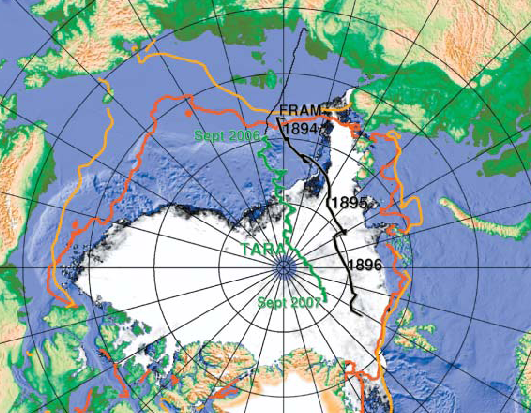|
Size: 900
Comment:
|
← Revision 21 as of 2009-03-09 09:54:04 ⇥
Size: 3916
Comment:
|
| Deletions are marked like this. | Additions are marked like this. |
| Line 6: | Line 6: |
| <<TableOfContents(2)>> |
|
| Line 9: | Line 11: |
== Ziele == Die CliSAP-Arbeitsgruppe "Arktische Variabilität" (AV) versteht sich als Basis für die instituts- und projektübergreifende Kommunikation zu dem Themenkomplex Klimawandel in der Arktis. Um die Kommunikation in Gang zu bringen, werden Arbeitstreffen zu bestimmten Themen in einem 4-8 wöchigen Rhythmus organisiert. Diese für alle Interessierten offenen Treffen sollen durch einen etwa 15-minütigen Impulsvortrag eingeleitet werden. In der darauf folgenden etwa 45-minütigen Diskussion sollen folgende Fragen beantwortet werden: Wer arbeitet an diesem Thema? Wie ist der aktuelle Stand des Wissens? Was sind die brennenden offenen Fragen? |
|
| Line 23: | Line 37: |
| === The rapid retreat of Arctic sea ice === 1.12.2008 Impulsvortrag (Lars Kaleschke) und Diskussion |
= Permafrost April/Mai 2009 (Lars Kutzbach) = = Interne Variabilität 10. März 2009 (Johann Jungclaus, Dirk Notz) = * Multidekadische Variabilität * Die Erwärmung in den 1930ern = The rapid retreat of Arctic sea ice 1.12.2008 (Lars Kaleschke, Dirk Notz, Nuno Serra) = == Summary == {{attachment:fram_tara_drift.png}} * Central Arctic (70N-90N) surface air temperature increased by 3°C since 1987 * Wind speed increased by 0.6 m/s since 1950 * Ice drift speed doubled since 1950 * September area decreased by 40% since 1990s * ~50% reduction of ice thickness in the transpolar drift since 2001 * Interannual thickness variability ~20% mainly controlled by thermodynamics * Model suggests thinning since 1987 at a rate of -20%/decade * 2007 ice extent strongly anomalous, ice mass loss not * Close to tipping point? == Questions == * How large is the internal variability? * Quality of data? * Reliability of models? == References == * [[http://www.agu.org/pubs/crossref/2008/2008EO030001.shtml|Gascard, J.-C., et al. (2008), Exploring Arctic Transpolar Drift During Dramatic Sea Ice Retreat, Eos Trans. AGU, 89(3), doi:10.1029/2008EO030001]] * [[http://www.agu.org/pubs/crossref/2008/2008GL034791.shtml| Hakkinen, S., A. Proshutinsky, and I. Ashik (2008), Sea ice drift in the Arctic since the 1950s, Geophys. Res. Lett., 35, L19704, doi:10.1029/2008GL034791.]] * [[http://www.arcus.org/search/seaiceoutlook/|Sea Ice Outlook]] * [[http://www.agu.org/pubs/crossref/2008/2008GL034457.shtml|Haas, C., A. Pfaffling, S. Hendricks, L. Rabenstein, J.-L. Etienne, and I. Rigor (2008), Reduced ice thickness in Arctic Transpolar Drift favors rapid ice retreat, Geophys. Res. Lett., 35, L17501, doi:10.1029/2008GL034457.]] * [[http://www.nature.com/nature/journal/v425/n6961/full/nature02050.html|Laxon et al., High interannual variability of sea ice thickness in the Arctic region, Nature 2003]] * [[http://www.agu.org/pubs/crossref/2007/2007GL031138.shtml|Nghiem, S. V., I. G. Rigor, D. K. Perovich, P. Clemente-Colón, J. W. Weatherly, and G. Neumann (2007), Rapid reduction of Arctic perennial sea ice, Geophys. Res. Lett., 34, L19504, doi:10.1029/2007GL031138.]] * [[http://ams.allenpress.com/archive/1520-0442/preprint/2008/pdf/10.1175_2008JCLI2521.1.pdf|Lindsay et al. (2008), Arctic Sea Ice Retreat in 2007 Follows Thinning Trend, Journal of Climate]] |
Contents
CliSAP Working Group Arctic Variability
Sprecher/Kontakt Lars Kaleschke
Ziele
Die CliSAP-Arbeitsgruppe "Arktische Variabilität" (AV) versteht sich als Basis für die instituts- und projektübergreifende Kommunikation zu dem Themenkomplex Klimawandel in der Arktis. Um die Kommunikation in Gang zu bringen, werden Arbeitstreffen zu bestimmten Themen in einem 4-8 wöchigen Rhythmus organisiert. Diese für alle Interessierten offenen Treffen sollen durch einen etwa 15-minütigen Impulsvortrag eingeleitet werden. In der darauf folgenden etwa 45-minütigen Diskussion sollen folgende Fragen beantwortet werden: Wer arbeitet an diesem Thema? Wie ist der aktuelle Stand des Wissens? Was sind die brennenden offenen Fragen?
Themen
- Wasser- und Energiebudget der Arktis (hydrologischer Kreislauf, Eisvolumen und -transport, Albedo)
- Interne Variabilität
- Response auf Variationen des externen Forcings (CO2, solare Einstrahlung, Vulkane)
- Biogeochemie der Arktis
- Schmelzen von Grönland
- Vermischungsprozesse auf dem Schelf
- Austausch Schelf-Ozean
- Numerik (Advektion, Meereismodellierung)
- Parametrisierungen für heterogene Grenzflächen
- Nicht hinreichend verstandene Prozesse (Meereis, Wolken)
- Permafrost/Gashydratdissoziation
Permafrost April/Mai 2009 (Lars Kutzbach)
Interne Variabilität 10. März 2009 (Johann Jungclaus, Dirk Notz)
- Multidekadische Variabilität
- Die Erwärmung in den 1930ern
The rapid retreat of Arctic sea ice 1.12.2008 (Lars Kaleschke, Dirk Notz, Nuno Serra)
Summary

- Central Arctic (70N-90N) surface air temperature increased by 3°C since 1987
- Wind speed increased by 0.6 m/s since 1950
- Ice drift speed doubled since 1950
- September area decreased by 40% since 1990s
- ~50% reduction of ice thickness in the transpolar drift since 2001
- Interannual thickness variability ~20% mainly controlled by thermodynamics
- Model suggests thinning since 1987 at a rate of -20%/decade
- 2007 ice extent strongly anomalous, ice mass loss not
- Close to tipping point?
Questions
- How large is the internal variability?
- Quality of data?
- Reliability of models?
